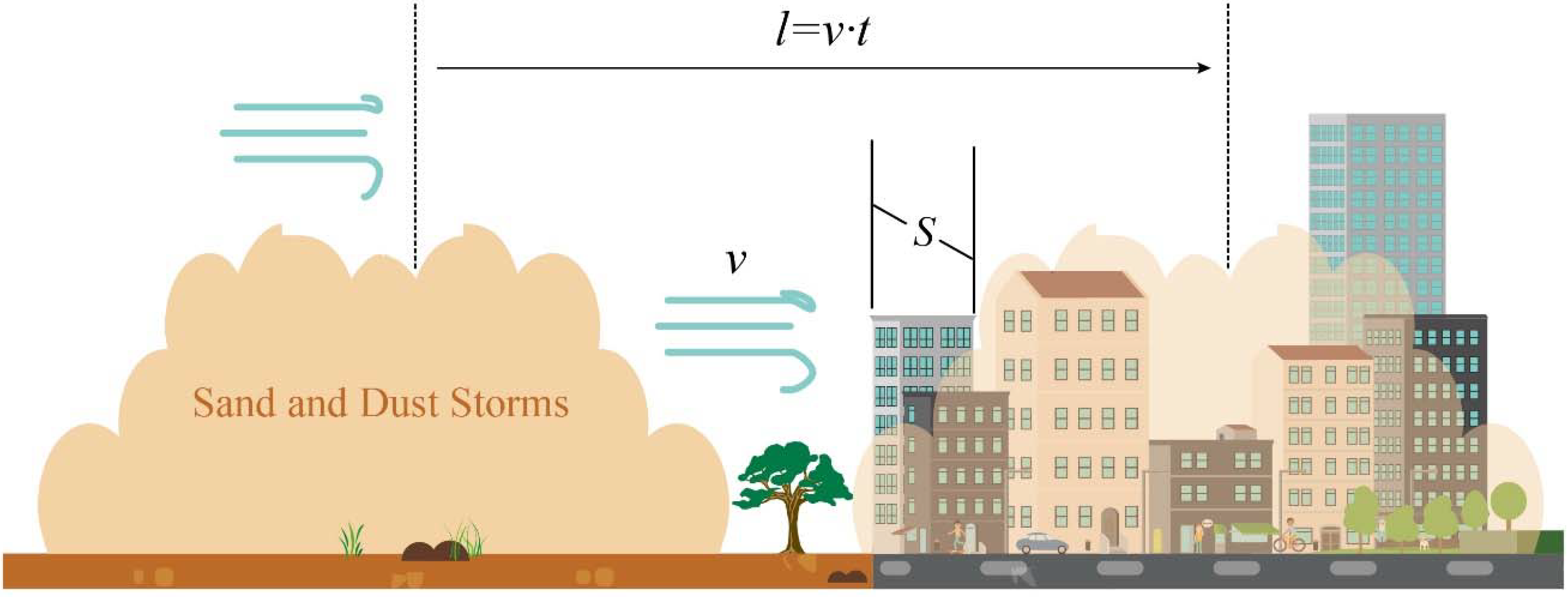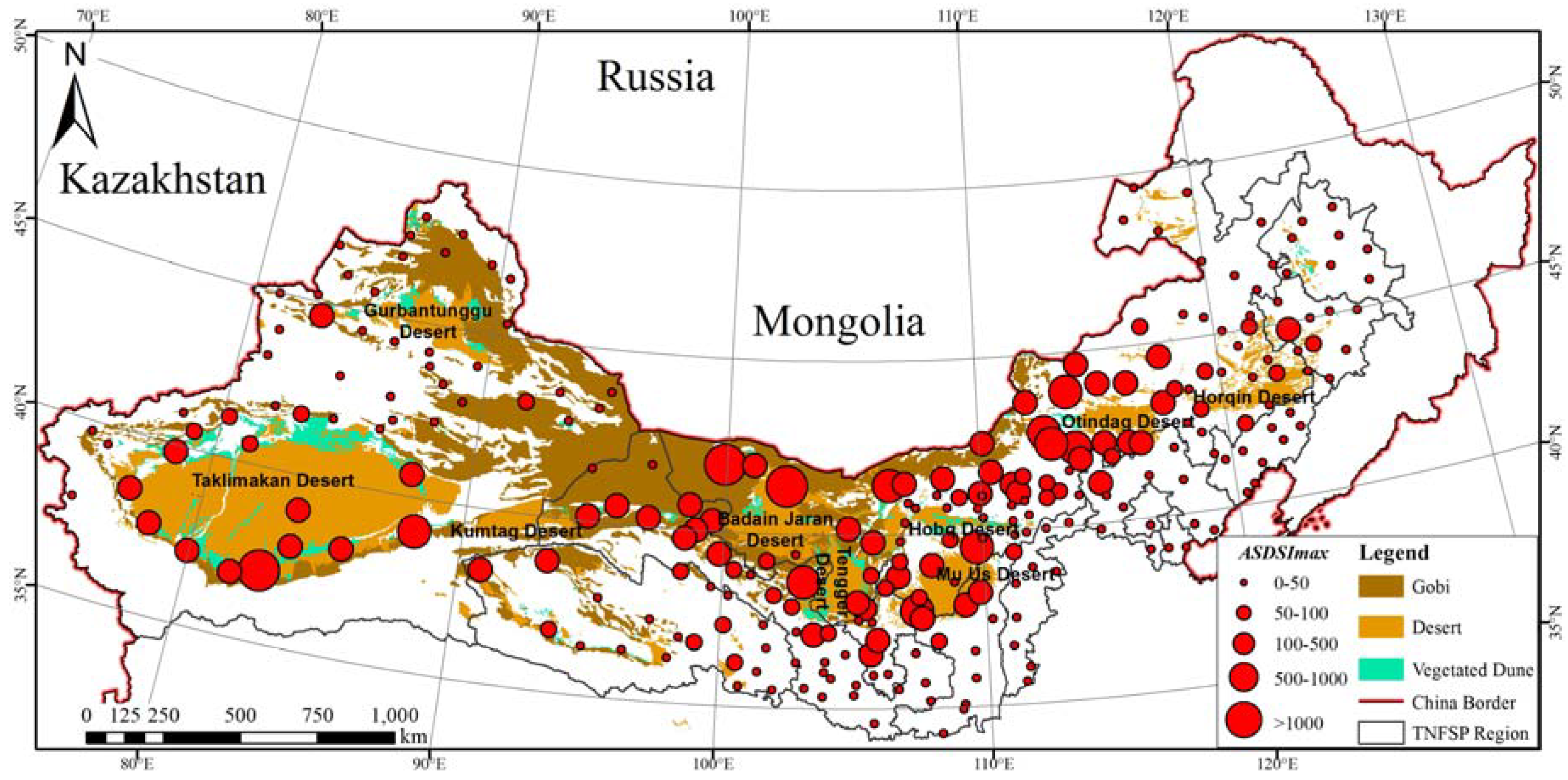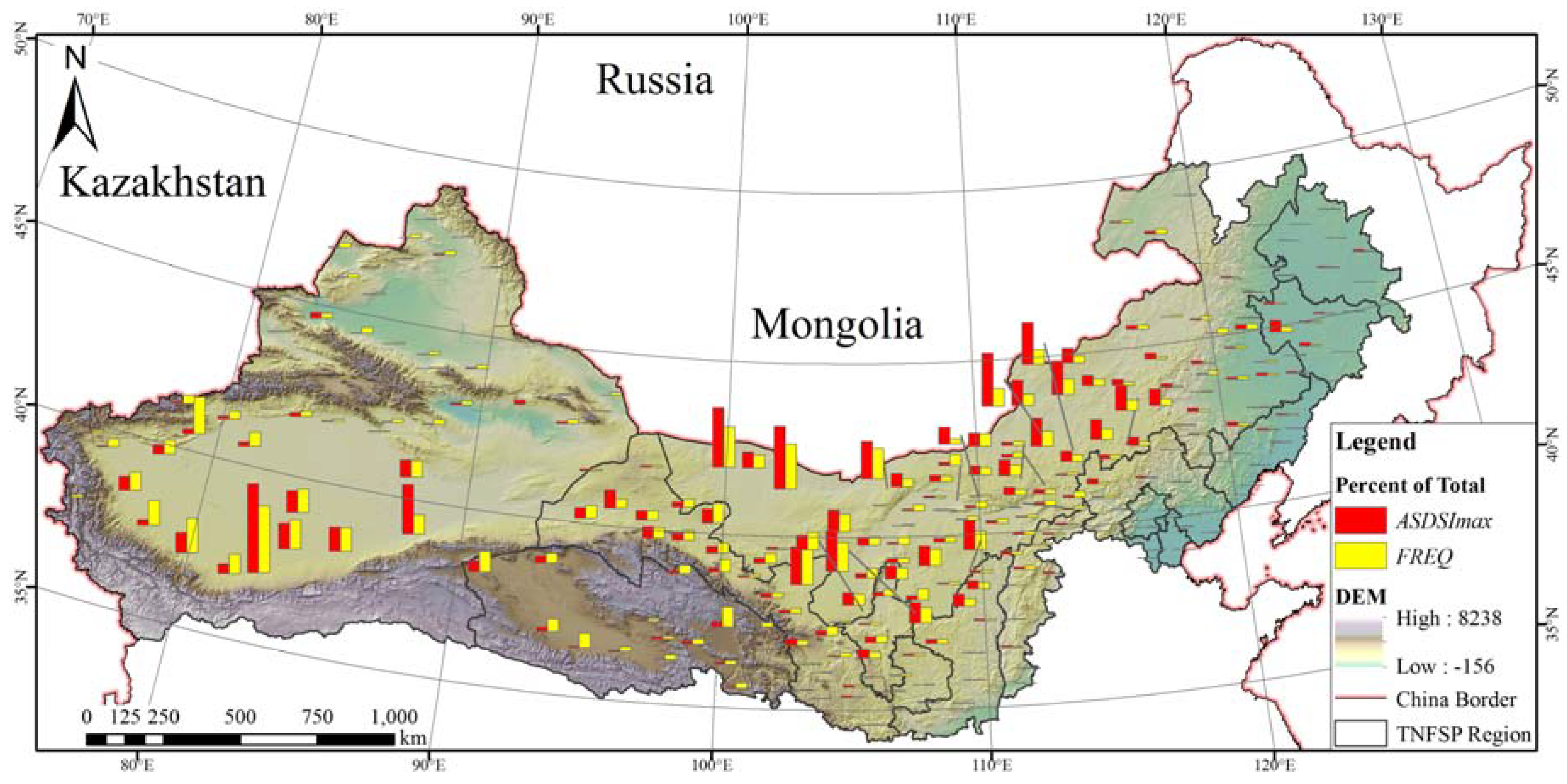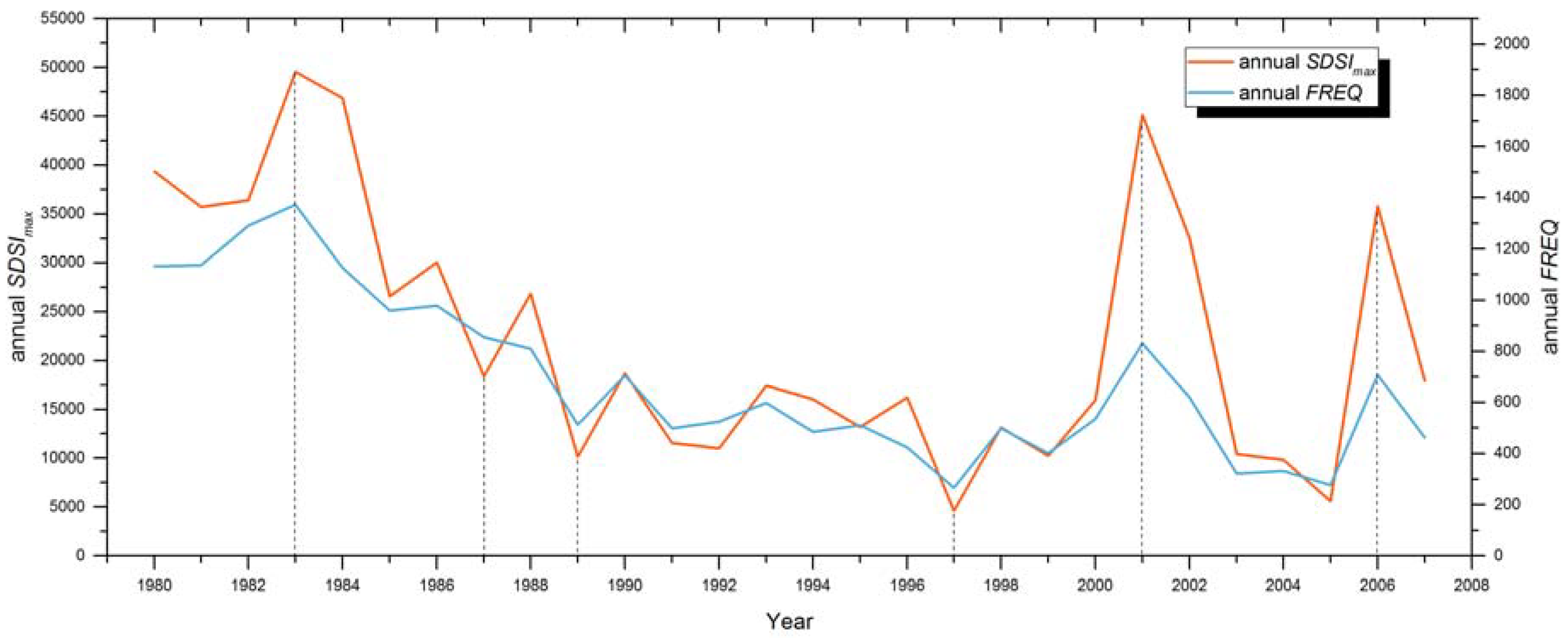Characterizing Sand and Dust Storms (SDS) Intensity in China Based on Meteorological Data
Abstract
1. Introduction
2. Materials and Methods
2.1. Study Area
2.2. Data
2.3. Sand and Dust Storms Index (SDSI)
3. Results and Discussion
3.1. Characteristics of ASDSImax and Its Components
3.2. Comparison of SDSI and SDS Frequency
3.3. Major Transportation Routes of Sand and Dust Storms in the TNFSP Region
4. Conclusions
Author Contributions
Acknowledgments
Conflicts of Interest
References
- Middleton, N.; Kang, U. Sand and Dust Storms: Impact Mitigation. Sustainability 2017, 9, 1053. [Google Scholar] [CrossRef]
- World Meteorological Organization; United Nations Environment Programme. Establishing a WMO Sand and Dust Storm Warning Advisory and Assessment System Regional Node for West Asia: Current Capabilities and Needs; World Meteorological Organization: Geneva, Switerland, 2013. [Google Scholar]
- Middleton, N. Dust storms in the Middle East. J. Arid Environ. 1986, 10, 83–96. [Google Scholar]
- China Meteorological Administration. Classification of Sand and Dust Weather. General Administration of Quality Supervision, Inspection and Quarantine of the People’s Republic of China; Standardization Administration of the People’s Republic of China: Beijing, China, 2017.
- Wang, S.; Wang, J.; Zhou, Z.; Shang, K. Regional characteristics of three kinds of dust storm events in China. Atmos. Environ. 2005, 39, 509–520. [Google Scholar] [CrossRef]
- Zhang, K.; Chai, F.; Zhang, R.; Xue, Z. Source, route and effect of Asian sand dust on environment and the oceans. Particuology 2010, 8, 319–324. [Google Scholar] [CrossRef]
- Goudie, A.; Middleton, N.J. Desert Dust in the Global System; Springer Science & Business Media: Berlin, Germany, 2006. [Google Scholar]
- Al-Dousari, A.; Doronzo, D.; Ahmed, M. Types, Indications and Impact Evaluation of Sand and Dust Storms Trajectories in the Arabian Gulf. Sustainability 2017, 9, 1526. [Google Scholar] [CrossRef]
- Cao, H.; Liu, J.; Wang, G.; Yang, G.; Luo, L. Identification of sand and dust storm source areas in Iran. J. Arid Land 2015, 7, 567–578. [Google Scholar] [CrossRef]
- Goudie, A.S. Dust storms: Recent developments. J. Environ. Manag. 2009, 90, 89–94. [Google Scholar] [CrossRef] [PubMed]
- United Nations Environment Programme; World Meteorological Organization; United Nations Convention to Combat Desertification. Global Assessment of Sand and Dust Storms; United Nations Environment Programme: Nairobi, Kenya, 2016. [Google Scholar]
- Shao, Y.; Wyrwoll, K.-H.; Chappell, A.; Huang, J.; Lin, Z.; McTainsh, G.H.; Mikami, M.; Tanaka, T.Y.; Wang, X.; Yoon, S. Dust cycle: An emerging core theme in Earth system science. Aeolian Res. 2011, 2, 181–204. [Google Scholar] [CrossRef]
- Goudarzi, G.; Daryanoosh, S.M.; Godini, H.; Hopke, P.K.; Sicard, P.; De, M.A.; Rad, H.D.; Harbizadeh, A.; Jahedi, F.; Mohammadi, M.J. Health risk assessment of exposure to the Middle-Eastern Dust storms in the Iranian megacity of Kermanshah. Public Health 2017, 148, 109–116. [Google Scholar] [CrossRef] [PubMed]
- Khaniabadi, Y.O.; Daryanoosh, M.; Sicard, P.; Takdastan, A.; Hopke, P.K.; Esmaeili, S.; De Marco, A.; Rashidi, R. Chronic obstructive pulmonary diseases related to outdoor PM10, O3, SO2, and NO2 in a heavily polluted megacity of Iran. Environ. Sci. Pollut. Res. Int. 2018, 25, 17726–17734. [Google Scholar] [CrossRef] [PubMed]
- Khaniabadi, Y.O.; Daryanoosh, S.M.; Amrane, A.; Polosa, R.; Hopke, P.K.; Goudarzi, G.; Mohammadi, M.J.; Sicard, P.; Armin, H. Impact of Middle Eastern Dust storms on human health. Atmos. Pollut. Res. 2017, 8, 606–613. [Google Scholar] [CrossRef]
- Khaniabadi, Y.O.; Fanelli, R.; De Marco, A.; Daryanoosh, S.M.; Kloog, I.; Hopke, P.K.; Conti, G.O.; Ferrante, M.; Mohammadi, M.J.; Babaei, A.A.; et al. Hospital admissions in Iran for cardiovascular and respiratory diseases attributed to the Middle Eastern Dust storms. Environ. Sci. Pollut. Res. Int. 2017, 24, 16860–16868. [Google Scholar] [CrossRef] [PubMed]
- Geravandi, S.; Sicard, P.; Khaniabadi, Y.O.; De Marco, A.; Ghomeishi, A.; Goudarzi, G.; Mahboubi, M.; Yari, A.R.; Dobaradaran, S.; Hassani, G.; et al. A comparative study of hospital admissions for respiratory diseases during normal and dusty days in Iran. Environ. Sci. Pollut. Res. Int. 2017, 24, 18152–18159. [Google Scholar] [CrossRef] [PubMed]
- Tozer, P.; Leys, J. Dust storms ? what do they really cost? Rangel. J. 2013, 35, 131–142. [Google Scholar] [CrossRef]
- Chen, J.; Li, G. Geochemical studies on the source region of Asian dust. Sci. China Earth Sci. 2011, 54, 1279–1301. [Google Scholar] [CrossRef]
- Shao, Y.; Dong, C.H. A review on East Asian dust storm climate, modelling and monitoring. Glob. Planet. Chang. 2006, 52, 1–22. [Google Scholar] [CrossRef]
- Wang, X.; Huang, J.; Ji, M.; Higuchi, K. Variability of East Asia dust events and their long-term trend. Atmos. Environ. 2008, 42, 3156–3165. [Google Scholar] [CrossRef]
- Youlin, Y.; Squires, V.; Qi, L. Global Alarm: Dust and Sandstorms from the World’s Drylands; United Nations: Bangkok, Thailand, 2001.
- Cao, H.; Amiraslani, F.; Liu, J.; Zhou, N. Identification of dust storm source areas in West Asia using multiple environmental datasets. Sci. Total Environ. 2015, 502, 224–235. [Google Scholar] [CrossRef] [PubMed]
- Li, G.; Chen, J.; Chen, Y.; Yang, J.; Ji, J.; Liu, L. Dolomite as a tracer for the source regions of Asian dust. J. Geophys. Res. Atmos. 2007, 112. [Google Scholar] [CrossRef]
- Xuan, J.; Sokolik, I.N.; Hao, J.; Guo, F.; Mao, H.; Yang, G. Identification and characterization of sources of atmospheric mineral dust in East Asia. Atmos. Environ. 2004, 38, 6239–6252. [Google Scholar] [CrossRef]
- Yang, J.; Li, G.; Rao, W.; Ji, J. Isotopic evidences for provenance of East Asian Dust. Atmos. Environ. 2009, 43, 4481–4490. [Google Scholar] [CrossRef]
- Yan, Y.; Sun, Y.; Ma, L.; Long, X. A multidisciplinary approach to trace Asian dust storms from source to sink. Atmos. Environ. 2015, 105, 43–52. [Google Scholar] [CrossRef]
- Li, G.; Chen, J.; Ji, J.; Yang, J.; Conway, T.M. Natural and anthropogenic sources of East Asian dust. Geology 2009, 37, 727–730. [Google Scholar] [CrossRef]
- Kim, J. Transport routes and source regions of Asian dust observed in Korea during the past 40 years (1965–2004). Atmos. Environ. 2008, 42, 4778–4789. [Google Scholar] [CrossRef]
- Shi, P.; Yan, P.; Yuan, Y.; Nearing, M.A. Wind erosion research in China: Past, present and future. Prog. Phys. Geogr. 2004, 28, 366–386. [Google Scholar] [CrossRef]
- Yang, H.; Zhang, X.; Zhao, F.; Wang, J.A.; Shi, P.; Liu, L. Mapping Sand-dust Storm Risk of the World. In World Atlas of Natural Disaster Risk; Shi, P., Kasperson, R., Eds.; Springer: Berlin/Heidelberg, Germany, 2015; pp. 115–150. [Google Scholar]
- Al-Hemoud, A.; Al-Sudairawi, M.; Neelamanai, S.; Naseeb, A.; Behbehani, W. Socioeconomic effect of dust storms in Kuwait. Arab. J. Geosci. 2017, 10, 18. [Google Scholar] [CrossRef]
- Daryanoosh, M.; Goudarzi, G.; Rashidi, R.; Keishams, F.; Hopke, P.K.; Mohammadi, M.J.; Nourmoradi, H.; Sicard, P.; Takdastan, A.; Vosoghi, M. Risk of morbidity attributed to ambient PM10 in the western cities of Iran. Toxin Rev. 2017. [Google Scholar] [CrossRef]
- Liu, G.; Park, S.U. The logarithm-linear relationship of the occurrence frequency to the duration of sand–dust storms: Evidence from observational data in China. J. Arid Environ. 2007, 71, 243–249. [Google Scholar] [CrossRef]
- Yao, Z.; Xiao, J.; Li, C.; Zhu, K. Regional characteristics of dust storms observed in the Alxa Plateau of China from 1961 to 2005. Environ. Earth Sci. 2010, 64, 255–267. [Google Scholar] [CrossRef]
- Wang, X.; Zhou, Z.; Dong, Z. Control of dust emissions by geomorphic conditions, wind environments and land use in northern China: An examination based on dust storm frequency from 1960 to 2003. Geomorphology 2006, 81, 292–308. [Google Scholar] [CrossRef]
- O’Loingsigh, T.; McTainsh, G.H.; Tews, E.K.; Strong, C.L.; Leys, J.F.; Shinkfield, P.; Tapper, N.J. The Dust Storm Index (DSI): A method for monitoring broadscale wind erosion using meteorological records. Aeolian Res. 2014, 12, 29–40. [Google Scholar] [CrossRef]
- Tan, M.; Li, X.; Xin, L. Intensity of dust storms in China from 1980 to 2007: A new definition. Atmos. Environ. 2014, 85, 215–222. [Google Scholar] [CrossRef]
- Wang, R.; Liu, B.; Li, H.; Zou, X.; Wang, J.; Liu, W.; Cheng, H.; Kang, L.; Zhang, C. Variation of strong dust storm events in Northern China during 1978–2007. Atmos. Res. 2017, 183, 166–172. [Google Scholar] [CrossRef]
- State Forestry Administration, People’s Republic of China. The Desertification and Sandification State of China: Bulletin; State Forestry Administration: Beijing, China, 2015.
- Wang, X.; Dong, Z.; Zhang, J.; Liu, L. Modern dust storms in China: An overview. J. Arid Environ. 2004, 58, 559–574. [Google Scholar] [CrossRef]
- Camino, C.; Cuevas, E.; Basart, S.; Alonso-Pérez, S.; Baldasano, J.M.; Terradellas, E.; Marticorena, B.; Rodríguez, S.; Berjón, A. An empirical equation to estimate mineral dust concentrations from visibility observations in Northern Africa. Aeolian Res. 2015, 16, 55–68. [Google Scholar] [CrossRef]
- Chepil, W.S.; Woodruff, N.P. Sedimentary Characteristics of Dust Storms 2. Visibility and dust concentration. Am. J. Sci. 1957, 255, 104–114. [Google Scholar] [CrossRef]
- Zhao, H.; Che, H.; Ma, Y.; Xia, X.; Wang, Y.; Wang, P.; Wu, X. Temporal variability of the visibility, particulate matter mass concentration and aerosol optical properties over an urban site in Northeast China. Atmos. Res. 2015, 166, 204–212. [Google Scholar] [CrossRef]
- Baddock, M.C.; Strong, C.L.; Leys, J.F.; Heidenreich, S.K.; Tews, E.K.; McTainsh, G.H. A visibility and total suspended dust relationship. Atmos. Environ. 2014, 89, 329–336. [Google Scholar] [CrossRef]
- Shao, Y. Northeast Asian dust storms: Real-time numerical prediction and validation. J. Geophys. Res. 2003, 108. [Google Scholar] [CrossRef]
- Qian, W.; Tang, X.; Quan, L. Regional characteristics of dust storms in China. Atmos. Environ. 2004, 38, 4895–4907. [Google Scholar] [CrossRef]
- Sun, J.; Zhang, M.; Liu, T. Spatial and temporal characteristics of dust storms in China and its surrounding regions, 1960–1999: Relations to source area and climate. J. Geophys. Res. Atmos. 2001, 106, 10325–10333. [Google Scholar] [CrossRef]
- China Meteorological Administration. Sand-Dust Weather Yearbook; China Meteorological Press: Beijing, China, 2001–2011.
- Xuan, J.; Sokolik, I.N. Characterization of sources and emission rates of mineral dust in Northern China. Atmos. Environ. 2002, 36, 4863–4876. [Google Scholar] [CrossRef]
- Wang, X.; Zhang, C.; Wang, H.; Qian, G.; Luo, W.; Lu, J.; Wang, L. The significance of Gobi desert surfaces for dust emissions in China: An experimental study. Environ. Earth Sci. 2011, 64, 1039–1050. [Google Scholar] [CrossRef]
- Wang, X.; Xia, D.; Wang, T.; Xue, X.; Li, J. Dust sources in arid and semiarid China and southern Mongolia: Impacts of geomorphological setting and surface materials. Geomorphology 2008, 97, 583–600. [Google Scholar] [CrossRef]
- Laurent, B.; Marticorena, B.; Bergametti, G.; Mei, F. Modeling mineral dust emissions from Chinese and Mongolian deserts. Glob. Planet. Chang. 2006, 52, 121–141. [Google Scholar] [CrossRef]
- Jugder, D.; Shinoda, M.; Sugimoto, N.; Matsui, I.; Nishikawa, M.; Park, S.-U.; Chun, Y.-S.; Park, M.-S. Spatial and temporal variations of dust concentrations in the Gobi Desert of Mongolia. Glob. Planet. Chang. 2011, 78, 14–22. [Google Scholar] [CrossRef]
- Shao, Y.; Wang, J. A climatology of Northeast Asian dust events. Meteorol. Z. 2003, 12, 187–196. [Google Scholar] [CrossRef]
- Uno, I.; Harada, K.; Satake, S.; Hara, Y.; Wang, Z.F. Meteorological characteristics and dust distribution of the Tarim Basin simulated by the nesting RAMS/CFORS dust model. J. Meteorol. Soc. Jpn. 2005, 83A, 219–239. [Google Scholar] [CrossRef]
- Chen, Y.; Zhang, W.; Chen, C.; Du, P.; Wang, X. Two types of the dust storms caused by cold air crossing the mountains in Xinjiang. In Proceedings of the Third International Asia-Pacific Environmental Remote Sensing, Remote Sensing of the Atmosphere, Ocean, Environment, and Space, Hangzhou, China, 23–27 October 2002. [Google Scholar]
- Wang, H.; Jia, X. Field Observations of Windblown Sand and Dust in the Takimakan Desert, NW China, and Insights into Modern Dust Sources. Land Degrad. Dev. 2013, 24, 323–333. [Google Scholar] [CrossRef]
- Abuduwaili, J.; Gabchenko, M.V.; Junrong, X. Eolian transport of salts—A case study in the area of Lake Ebinur (Xinjiang, Northwest China). J. Arid Environ. 2008, 72, 1843–1852. [Google Scholar] [CrossRef]
- Ge, Y.; Abuduwaili, J.; Ma, L.; Wu, N.; Liu, D. Potential transport pathways of dust emanating from the playa of Ebinur Lake, Xinjiang, in arid northwest China. Atmos. Res. 2016, 178–179, 196–206. [Google Scholar] [CrossRef]
- Yan, C.Z.; Zhou, Y.M.; Song, X.; Duan, H.C. Estimation of areas of sand and dust emission in the Hexi Corridor from a land cover database: An approach that combines remote sensing with GIS. Environ. Geol. 2008, 57, 707–713. [Google Scholar] [CrossRef]
- Zhang, Z.; Dong, Z.; Li, J.; Qian, G.; Jiang, C. Implications of surface properties for dust emission from gravel deserts (gobis) in the Hexi Corridor. Geoderma 2016, 268, 69–77. [Google Scholar] [CrossRef]
- Wang, X.; Huang, N.; Dong, Z.; Zhang, C. Mineral and trace element analysis in dustfall collected in the Hexi Corridor and its significance as an indicator of environmental changes. Environ. Earth Sci. 2009, 60, 1–10. [Google Scholar] [CrossRef]
- Qiang, M.; Chen, F.; Zhou, A.; Xiao, S.; Zhang, J.; Wang, Z. Impacts of wind velocity on sand and dust deposition during dust storm as inferred from a series of observations in the northeastern Qinghai–Tibetan Plateau, China. Powder Technol. 2007, 175, 82–89. [Google Scholar] [CrossRef]
- Tan, M.; Li, X. Does the Green Great Wall effectively decrease dust storm intensity in China? A study based on NOAA NDVI and weather station data. Land Use Policy 2015, 43, 42–47. [Google Scholar] [CrossRef]
- Wang, X.M.; Zhang, C.X.; Hasi, E.; Dong, Z.B. Has the Three Norths Forest Shelterbelt Program solved the desertification and dust storm problems in arid and semiarid China? J. Arid Environ. 2010, 74, 13–22. [Google Scholar] [CrossRef]
- Han, J.; Zhang, Y.; Wang, C.; Bai, W.; Wang, Y.; Han, G.; Li, L. Rangeland degradation and restoration management in China. Rangel. J. 2008, 30, 233–239. [Google Scholar] [CrossRef]
- Zhang, Q.-Y.; Zhao, X.-Y.; Zhang, Y.; Li, L. Preliminary study on sand-dust storm disaster and countermeasures in China. Chin. Geogr. Sci. 2002, 12, 9–13. [Google Scholar] [CrossRef]
- Natsagdorj, L.; Jugder, D.; Chung, Y.S. Analysis of dust storms observed in Mongolia during 1937–1999. Atmos. Environ. 2003, 37, 1401–1411. [Google Scholar] [CrossRef]






© 2018 by the authors. Licensee MDPI, Basel, Switzerland. This article is an open access article distributed under the terms and conditions of the Creative Commons Attribution (CC BY) license (http://creativecommons.org/licenses/by/4.0/).
Share and Cite
Cao, H.; Fu, C.; Zhang, W.; Liu, J. Characterizing Sand and Dust Storms (SDS) Intensity in China Based on Meteorological Data. Sustainability 2018, 10, 2372. https://doi.org/10.3390/su10072372
Cao H, Fu C, Zhang W, Liu J. Characterizing Sand and Dust Storms (SDS) Intensity in China Based on Meteorological Data. Sustainability. 2018; 10(7):2372. https://doi.org/10.3390/su10072372
Chicago/Turabian StyleCao, Hui, Chao Fu, Wanfeng Zhang, and Jian Liu. 2018. "Characterizing Sand and Dust Storms (SDS) Intensity in China Based on Meteorological Data" Sustainability 10, no. 7: 2372. https://doi.org/10.3390/su10072372
APA StyleCao, H., Fu, C., Zhang, W., & Liu, J. (2018). Characterizing Sand and Dust Storms (SDS) Intensity in China Based on Meteorological Data. Sustainability, 10(7), 2372. https://doi.org/10.3390/su10072372




